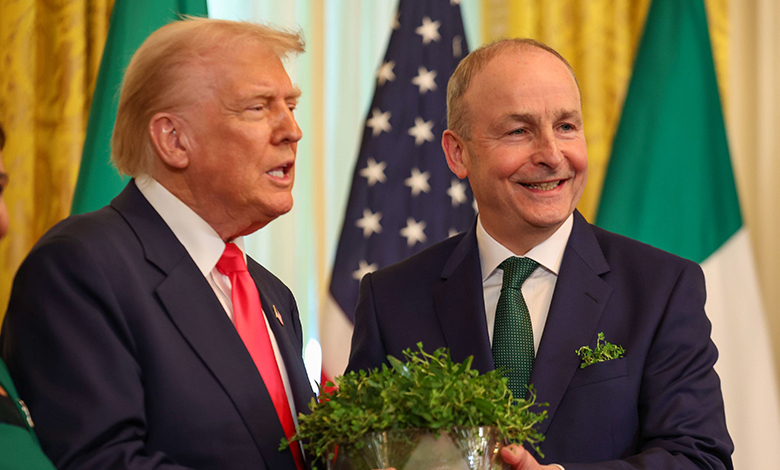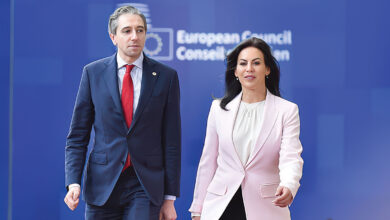Trump’s economic threat to Ireland intensifies

Having survived tests from Europe, the Irish tax regime now faces its toughest challenge from the US. Eamon Quinn writes for eolas Magazine.
The stakes were considerably lower last time. A spat in the final years of President Donald Trump’s first term only came to the boil as the US took aim at alleged EU subsidies to European aerospace manufacturing giant Airbus. With Trump’s defeat in 2020, tempers cooled but not before the EU had answered with its own import tariffs targeting bourbon and Harley-Davidson motorcycles.
Trump escalated the tit-for-tat food fight by slapping tariff hikes on French wine and cheese. Some €250 million worth of Irish dairy and drinks products sold into the US, including Kerrygold butter and Irish whiskeys, got caught up in the bun fight.
However, for Europe and Ireland in particular, the economic threat level under Trump’s second term has risen alarmingly.
Trump started out with a bewildering barrage of tariffs on manufactured goods imported from Canada and Mexico, only for the White House to pause and then restart many of the measures after exempting car and truck manufacturers. The White House moved quickly to impose tariffs on all Chinese goods arriving at US ports and has since warned the global manufacturing powerhouse it plans to inflict more pain.
Europe also faces a horrible countdown. With the rest of the world, the EU has already been served with increased tariffs on steel and aluminium products sold into the US.
The same steel tariffs also apply to Britain even as its Washington ambassador Peter Mandelson insists Brexit-damaged Britain could still strike its own trade deal with the US.
Separate gatherings that Trump hosted in February 2025, with President Emmanuel Macron and Prime Minister Keir Starmer, were favourably reported by the respective French and British media. Taoiseach Micheál Martin benefitted from similar flattering coverage at home, although much of the reporting here contrasted with the accounts of international outlets. “Trump takes on Ireland at St Patrick’s Day event” ran the headline above The Wall Street Journal’s report of the 12 March 2025 encounter in the White House.
The White House soon returned to teasing and goading. Styled by Trump officials as “Liberation Day” for the US, a set of new trade announcements is scheduled for 2 April 2025. And worryingly, US Commerce Secretary Howard Lutnick has made no secret that Ireland’s tax regime is on his mind.
Trump had campaigned on promises to impose universal tariffs on imports and to slash the rate of US corporation tax to 15 per cent. On the eve of his November victory, Irish Government ministers and officials should have been in no doubt that second-term Trump was better placed to deliver on his turbo-charged America First pledges.
By most economic measures, the Republic has benefited hugely from a tax regime that first pulled in huge numbers of US multinationals, and then almost by accident, delivered fiscal bounties for the State.
“Official figures starkly show how prosperity in the Republic is closely tied with corporation tax, accounting regimes, and US multinationals.”
With little to lose after the debt and joblessness crises of the late 1980s, Irish policy all but stumbled across the winning formula. The European Commission did not pay much attention and approved Ireland’s move in the 1990s to fix its low corporation rate.
France and Germany only started to take notice when US multinationals like Apple and Google set up major tax accounting bases here that paid a small but nonetheless outsized slice of their profit to the Irish exchequer generated from their international revenues.
By the 2000s, Paris and Berlin championed the so-called Common Consolidated Corporate Tax Base, a way of sharing out the spoils of the US profit taxes across Europe to the benefit of the most populous countries. The idea never really went away. Famously, barely a fortnight after coming to power in 2011, former Taoiseach Enda Kenny faced what he described as a bit of “a Gallic spat” with Nicolas Sarkozy, the then-French President.
Sarkozy wanted Ireland to increase its competitive corporate tax rate as the price of securing reductions in the penal interest rates the Europeans were initially charging for their bailout loans.
Almost as significantly, the Republic continued to benefit from the disarray among US legislators over global tax.
Following a 2013 US Senate Committee hearing into Apple’s tax affairs involving Ireland, former Finance Minister Michael Noonan quietly started to phase out the most egregious accounting wheezes favouring multinationals here. By 2021, the Irish Government conceded a major principle: It was forced to hike the corporation tax rate to 15 per cent under the global overhaul driven by the OECD and endorsed by former US President Joe Biden and his Treasury Secretary Janet Yellen. But the higher rate only applied to the largest corporations, and the broader Irish tax regime survived intact.
More recently, the tax model helped the economy navigate the fallout of the Brexit referendum in 2016 as successive UK governments wilfully aimed to sow economic and political turmoil across the island.
Enter nativist Trump for his second term. Official figures starkly show how prosperity in the Republic is closely tied with corporation tax, accounting regimes, and US multinationals.
Across Ireland, over 950 big American companies employ 210,000 people, including 6,000 jobs at Apple in Cork and the 3,500 posts that Microsoft employs in south Dublin and in Belfast. US chipmaker Intel and US pharma giants – including Eli Lilly which sources some of its weight-loss compounds for world markets in Ireland and Pfizer – employ over 13,000 people at multiple sites here.
Corporation taxes paid by US multinationals have helped hoist the Irish exchequer high up the rankings as the richest in Europe. Boosted by the Apple tax-back billions, 2024’s corporation tax haul amounted to an enormous €39 billion.
And at almost €73 billion, the value of goods exported to the US last year accounted for just under one-third of all global goods exported from the Republic. This successful mix of the tax lure for US corporations and significant trade surpluses has now made Ireland peculiarly vulnerable to the Trump onslaught, experts say.
Excluding any new measures on 2 April, the Central Bank in March 2025 had warned about the “seismic shift” entailed by Trump’s attempts to reset global trade. The Economic and Social Research Institute (ESRI) has estimated the hit to Irish GDP could run to billions of euros, albeit over several years, should the US deploy its full tariff artillery.
The Irish tax regime survived tests from Europe for the past 25 years but now faces its toughest challenge from the US.





